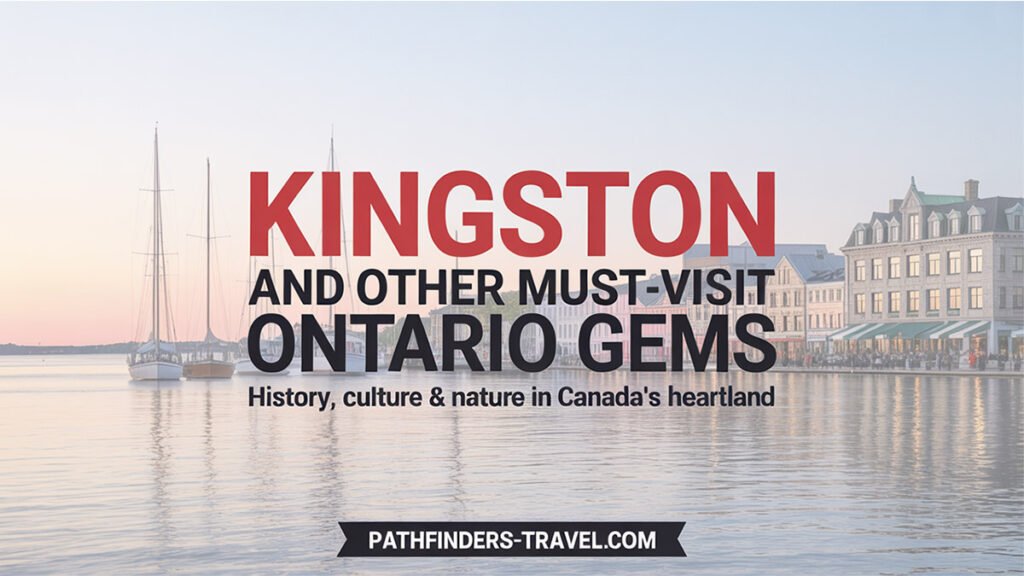Estimated reading time: 20 minutes
Key Takeaways
- Ontario offers diverse experiences from vibrant urban centers to stunning natural landscapes
- Toronto’s multicultural neighborhoods and landmarks like the CN Tower make it a hub for entertainment and culture
- Parliament Hill in Ottawa showcases Canada’s rich political heritage through Gothic Revival architecture
- Kingston’s maritime charm and historic sites offer a perfect blend of history and waterfront activities
- Hamilton is known as the City of Waterfalls with over 100 cascades within its boundaries
- Science North in Sudbury highlights the city’s remarkable environmental transformation
- Brockville serves as a gateway to the Thousand Islands, offering scenic river activities
Table of Contents
- Introduction
- Things to Do in Toronto: Attractions, Neighborhoods, and Itinerary Ideas
- Visiting Ottawa Parliament Hill
- What to Do in Kingston, Ontario
- Guide to Hamilton, City of Waterfalls
- Sudbury Science North and Regreening
- Brockville: Thousand Islands Gateway
- Frequently Asked Questions about Ontario Cities
- Conclusion
Introduction
Ontario is a remarkable blend of vibrant urban centers and stunning natural landscapes. When considering what to do in Kingston Ontario and other regions of this diverse province, travelers discover a destination that caters to all interests. The province’s unique appeal comes from its ability to balance cosmopolitan experiences with pristine wilderness areas, making it perfect for those seeking both nature and culture.
From the bustling streets of Toronto with countless things to do in Toronto to the historic charm of visiting Ottawa Parliament Hill, Ontario offers experiences that range from urban excitement to tranquil retreats. Whether you’re exploring the guide to Hamilton city of waterfalls, learning about Sudbury Science North and regreening efforts, or using Brockville Thousand Islands gateway for aquatic adventures, Ontario delivers rich and varied travel experiences.
The province’s geographic diversity creates opportunities for countless adventures, from the cosmopolitan streets of major cities to the peaceful shores of the Great Lakes and everything in between. [SOURCE]
Want to plan your Ontario trip? Click here to jump to the video in UHD 4K Resolution.
Things to Do in Toronto: Attractions, Neighborhoods, and Itinerary Ideas
Toronto captivates visitors with its vibrant urban energy and multicultural neighborhoods. As Canada’s largest city, Toronto offers an exciting mix of landmarks and experiences that reflect its status as one of the most diverse cities in the world, with residents speaking over 140 languages and dialects.
The iconic CN Tower defines Toronto’s skyline, standing tall against the backdrop of gleaming skyscrapers. When completed in 1976, it held the title of world’s tallest freestanding structure for over three decades. Visitors can walk on the glass floor 342 meters above the ground or take part in the EdgeWalk, circling the tower’s exterior while suspended by a harness for the truly brave.
Toronto’s Entertainment District pulses with energy, hosting Broadway-caliber shows in historic theaters that light up King Street each night. Sports fans can catch Blue Jays games at Rogers Centre or watch the Maple Leafs and Raptors at Scotiabank Arena. The area also features Ripley’s Aquarium, where visitors can observe marine life through underwater tunnels. [SOURCE]
Just steps away, the Distillery District offers a different atmosphere. Its Victorian-era buildings now house art galleries and boutique shops on cobblestone streets. What was once the largest distillery in the British Empire has been transformed into a car-free cultural hub where visitors can enjoy unique dining experiences and local crafts.
The city’s multicultural neighborhoods are must-visit destinations. Kensington Market buzzes with vintage shops, global cuisines, and street art. Chinatown offers authentic Asian dining experiences, while Little Italy and Greektown showcase their respective cultural heritage through food, festivals, and community spaces. These districts provide an authentic taste of Toronto’s cultural diversity that goes beyond typical tourist attractions.
For a break from urban exploration, Toronto’s waterfront provides scenic views of Lake Ontario. The revitalized harbor area features parks, walking trails, and beaches where visitors can relax and enjoy outdoor activities. During summer months, the waterfront hosts festivals, outdoor concerts, and cultural events that showcase the city’s vibrant arts scene.
Toronto’s constant evolution makes it not just a destination but a living example of what a modern multicultural city can be. New developments and immigrant communities continue to shape the city’s identity, creating new experiences for return visitors to discover. Beyond the popular attractions, Toronto rewards those who venture into its diverse neighborhoods with authentic local experiences.
Visiting Ottawa Parliament Hill: History, Tours, and Nearby Sights
Parliament Hill stands as Ottawa’s historical and political heart, a symbol of Canadian democracy perched dramatically on a limestone cliff overlooking the Ottawa River. The site was established in 1858 after Queen Victoria chose Ottawa as Canada’s capital, selecting the location for its strategic position and natural beauty.
The historical importance of Parliament Hill extends beyond its architectural grandeur. This is where Canada’s most significant national ceremonies take place, including Canada Day celebrations and the Changing of the Guard. It’s also the working seat of Canada’s federal government, where laws are debated and passed in the House of Commons and the Senate. [SOURCE]
The Parliament Buildings showcase stunning Gothic Revival architecture, considered among the finest examples in the British Empire. The complex features dramatic facades, spires, and the iconic Peace Tower that rises 92.2 meters above the grounds. The Centre Block’s intricate stonework, gargoyles, and pointed arches create an impressive sight, especially when illuminated at night. The buildings were reconstructed after a devastating fire in 1916, preserving their historical character while incorporating modern elements.
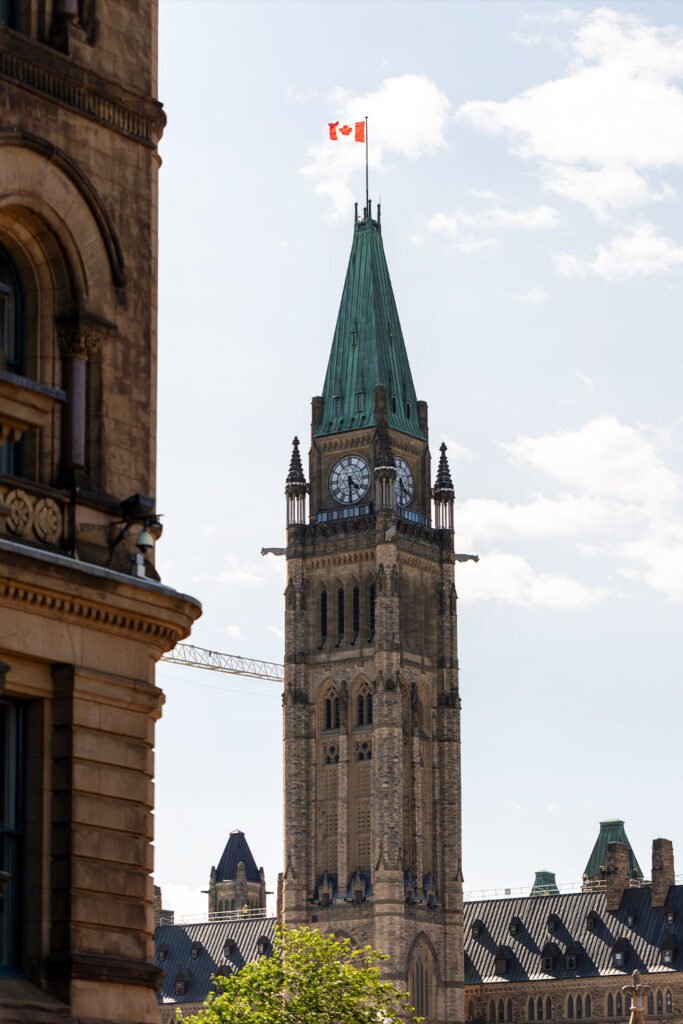
The grounds surrounding Parliament Hill are equally impressive, with beautifully landscaped lawns, heritage statues, and monuments that tell stories from Canada’s past. Free guided tours of the Parliament Buildings allow visitors to see the Senate, House of Commons, Library of Parliament, and Peace Tower, offering insights into Canada’s parliamentary system and history.
Just steps from Parliament Hill, the Rideau Canal winds through downtown Ottawa. This UNESCO World Heritage Site was built in the 1820s as a military supply route after the War of 1812. During summer, the canal buzzes with boats and cyclists along its pathways. Winter transforms it into the world’s largest naturally frozen skating rink, extending 7.8 kilometers through the heart of the city.
Across the Ottawa River lies Gatineau Park, a vast conservation area offering a wilderness escape minutes from the capital. This 361-square-kilometer natural playground features hiking trails through forests that burst with spectacular fall colors. From Champlain Lookout, visitors gain breathtaking views of the Ottawa River Valley with the capital spread below. The park provides year-round recreational opportunities, from summer hiking and biking to winter cross-country skiing.
Ottawa balances its role as a political center with abundant cultural attractions. The National Gallery of Canada, with its striking glass architecture, houses an impressive collection of Canadian and international art. The nearby Canadian Museum of History explores the country’s 20,000 years of human history through engaging exhibits and the world’s largest indoor collection of totem poles.
What to Do in Kingston, Ontario: Historic Sites, Waterfront, and Thousand Islands Tours
Kingston, Ontario, offers visitors a captivating blend of rich history and maritime charm. Located where Lake Ontario meets the St. Lawrence River, Kingston’s strategic position has shaped its development from a military outpost to a vibrant waterfront city with unique cultural attractions.
The city’s history as the first capital of a united Canada (1841-1844) is visible in its distinctive 19th-century limestone buildings that give downtown its uniform gray color that turns golden at sunset. This architectural heritage earned Kingston its nickname “The Limestone City” and provides a stunning backdrop for exploring the historic downtown area.
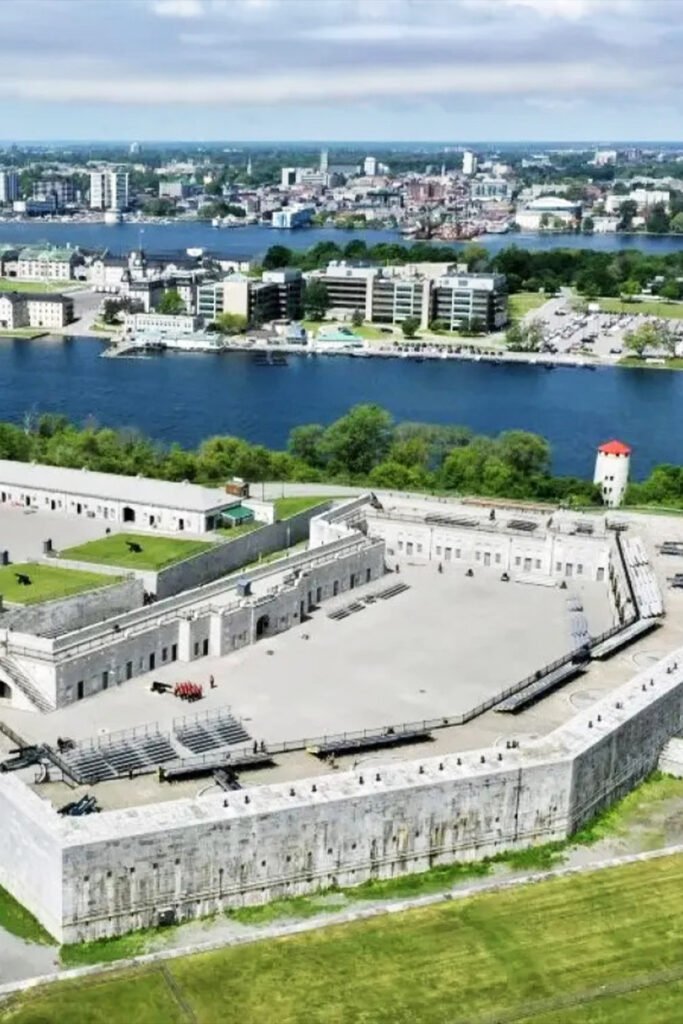
Fort Henry stands as Kingston’s most impressive historical attraction. Built in the 1830s to defend against American invasion, this massive stone fortress features walls 10 feet thick, designed to withstand cannon fire that never came. Today, visitors can watch students in period uniforms perform rifle drills, explore the barracks and defensive systems, and enjoy panoramic views of the city and harbor from its hilltop position. The fort hosts special events throughout the summer, including sunset ceremonies and military reenactments that bring history to life.
Kingston’s historic downtown invites exploration with its pedestrian-friendly streets lined with shops, restaurants, and galleries housed in preserved limestone buildings. Springer Market Square, behind City Hall, hosts one of Ontario’s oldest public markets where local farmers and artisans sell their products. The area comes alive during summer with outdoor patios, street performers, and festivals celebrating Kingston’s rich cultural heritage.
The waterfront forms an integral part of Kingston’s identity and offers numerous activities for visitors. Confederation Park provides green space along the harbor with walking paths, benches, and magnificent views of the harbor. From here, you can watch sailboats and tour boats coming and going against the backdrop of historic buildings. The waterfront pathway connects various attractions, including the Marine Museum of the Great Lakes, which documents Kingston’s shipbuilding history and maritime heritage.
What to do in Kingston Ontario, often includes exploring the St. Lawrence River and Thousand Islands region. Kingston serves as an ideal starting point for boat tours that showcase this natural wonder, where the river widens and splits around granite islands. These cruises provide stunning views of island cottages, historic sites, and natural landscapes while guides share stories about the region’s history and ecology.
For those seeking a more active experience, kayaking offers an intimate way to discover Kingston’s waterfront and nearby islands. Local outfitters provide equipment rentals and guided tours suitable for beginners and experienced paddlers alike. The protected waters around Kingston make it perfect for gentle paddling adventures with plenty of coves and channels to explore.
Beyond the waterfront, Kingston boasts hidden cultural gems worth discovering. The Agnes Etherington Art Centre at Queen’s University houses an impressive collection including European masters and contemporary Canadian works. The Penitentiary Museum, housed in the former warden’s residence of Kingston Penitentiary, offers fascinating insights into Canada’s correctional history.
Guide to Hamilton, City of Waterfalls and Hiking Trails
Hamilton has earned its reputation as the City of Waterfalls with over 100 cascades within its boundaries, more than any other Canadian city. This natural phenomenon exists because the city sits where the Niagara Escarpment meets Lake Ontario, creating a 300-foot elevation change. Streams flowing off the escarpment have no choice but to drop, forming spectacular waterfalls throughout the region. [SOURCE]
Among Hamilton’s most impressive waterfalls, Albion Falls spans 62 feet wide and drops 62 feet, creating a perfect square of falling water. The cascade has carved a bowl in the soft shale below, forming pools deep enough to swim in during high water periods. The city has built viewing platforms for safe observation, though locals know the unmarked trails that lead behind the falls for a more immersive experience.
Just upstream, Tews Falls drops 134 feet in a narrow ribbon, making it the tallest waterfall in the region and second-highest in Ontario after Niagara Falls. It spills from the edge of the escarpment into a deep gorge by Spencer Creek, framed by layers of exposed rock and dense greenery in summer. The nearby trail leads to scenic overlooks where visitors can feel the cool spray drifting up from below.
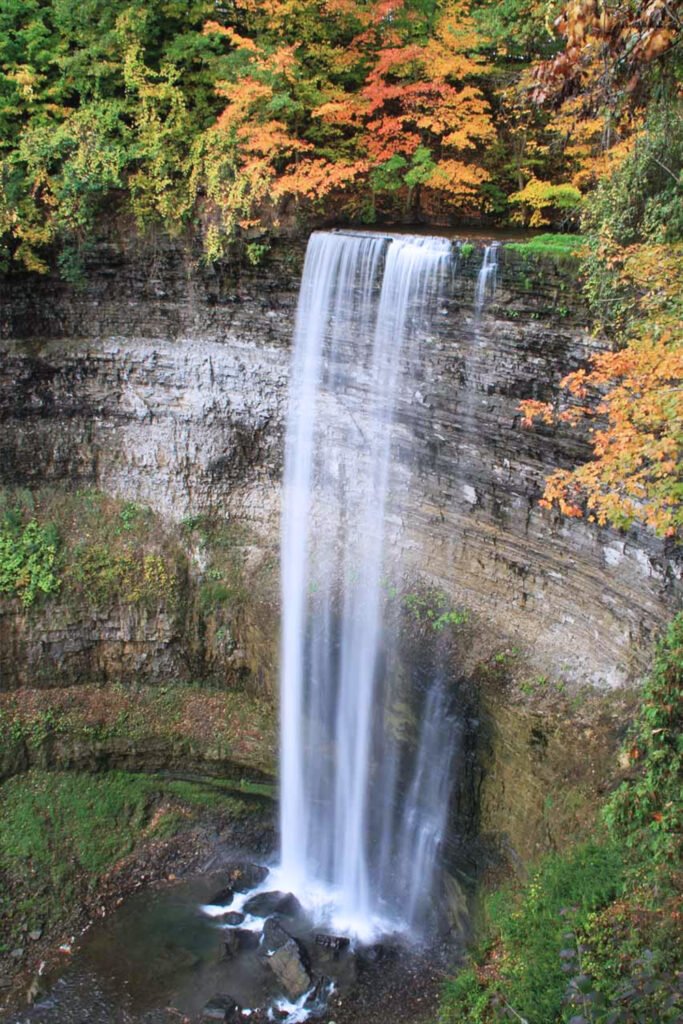
For those seeking less crowded experiences, Hamilton offers numerous hidden waterfalls worth discovering. Webster’s Falls features a classic wide curtain of water with a stone footbridge above providing perfect photo opportunities. Devil’s Punchbowl showcases colorful rock layers in its bowl-shaped gorge, while Felker’s Falls offers a serene setting often missed by tourists.
The best times to visit Hamilton’s waterfalls are during spring runoff (April-May) when water volumes are highest, creating the most dramatic views. Fall offers another prime viewing season when colorful foliage frames the cascades. Summer visits allow for more comfortable hiking but water levels may be lower. Winter transforms many falls into spectacular ice formations, though trail conditions can be treacherous.
For waterfall enthusiasts, several recommended trails connect multiple falls. The Bruce Trail, Canada’s oldest and longest marked hiking path, follows the Niagara Escarpment for 550 miles from Niagara to Tobermory and passes near many of Hamilton’s waterfalls. The Chedoke Radial Trail offers a more accessible route along an old railway line with connections to several falls.
Beyond waterfalls, Hamilton offers complementary cultural attractions that make for a well-rounded visit. The Royal Botanical Gardens features extensive collections of plants and themed gardens spanning 2,700 acres. Downtown Hamilton has undergone revitalization, particularly in the James Street North district where art galleries, studios, and independent shops have transformed former industrial spaces.
When planning a waterfall tour, visitors should wear sturdy footwear, bring water and snacks, and respect trail closures and safety barriers. Many falls are located in environmentally sensitive areas, so staying on marked trails helps preserve these natural wonders for future generations. Free parking can be limited at popular sites, so arriving early or visiting on weekdays helps avoid crowds.
Sudbury Science North and Regreening: Environmental Recovery and Visitor Guide
Sudbury has undergone a remarkable transformation from an industrial mining town with an environmentally damaged landscape to a leader in environmental rehabilitation and science education. The city sits in a 40-mile-wide basin created by a meteorite impact 1.8 billion years ago – the second largest known impact crater on Earth. The nickel and copper deposits that made the city’s fortune came from this cosmic collision. [SOURCE]
For decades, smelter emissions from mining operations killed most vegetation around the city, leaving bare black rock and earning Sudbury an unwanted reputation for its moonlike landscape. Starting in the 1970s, the city began an ambitious regreening program that has become a global model for environmental recovery. Volunteers and organizations have planted over 10 million trees as part of this initiative, demonstrating what’s possible when a community commits to healing environmental damage.
The results of these regreening efforts are visible throughout the region. Areas once completely barren now support healthy forests and vegetation. Lakes that were once highly acidified have recovered enough to support fish and other aquatic life. Wildlife has returned to areas where it had disappeared for generations. This environmental success story has drawn international attention and established Sudbury as a center for research on ecosystem recovery.
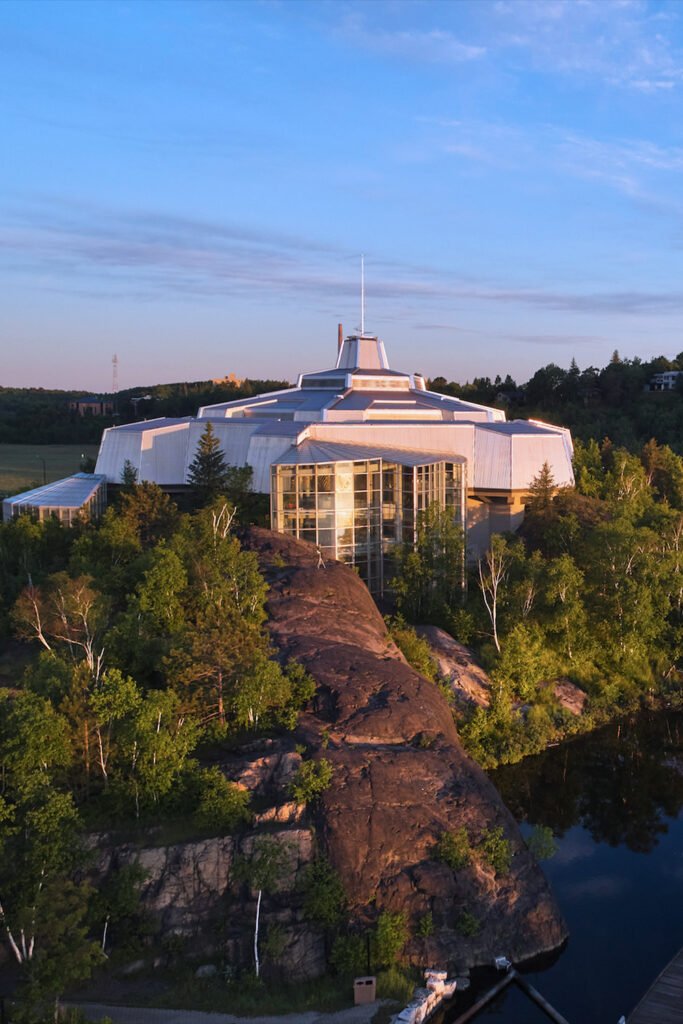
Science North, one of the city’s premier attractions, showcases this environmental transformation while offering educational experiences for visitors of all ages. Built on the shore of Ramsey Lake in 1984, the science center is housed in two snowflake-shaped buildings designed to blend with the rock outcrop they sit on. The innovative architecture symbolizes Sudbury’s connection to both science and nature.
Inside Science North, interactive exhibits engage visitors with principles of earth sciences, biology, physics, and chemistry. The facility includes specialty areas like a butterfly gallery, a digital planetarium, and labs where visitors can participate in real experiments. The Climate Change Lab offers a particularly relevant experience, allowing visitors to understand environmental challenges and solutions, including Sudbury’s own regreening story.
The nearby Dynamic Earth underground mining museum complements Science North by focusing on Sudbury’s geological history and mining heritage. Visitors can descend into a demonstration mine to experience the conditions of underground work and learn about modern mining technologies. The site is marked by the Big Nickel, a 30-foot replica of a Canadian five-cent coin that has become a city landmark.
Today, Sudbury serves as a leader in sustainability and eco-tourism. Lake Ramsey sits right in the city, big enough for sailboats and deep enough for lake trout. The waterfront features parks and trails where visitors can enjoy recreational activities while appreciating the results of environmental recovery efforts. The city’s network of conservation areas and provincial parks offers hiking, canoeing, and wildlife viewing opportunities within minutes of downtown.
The transformation of Sudbury represents an important story of environmental hope and human ingenuity. From barren rock to thriving ecosystem, the city demonstrates how damaged landscapes can be healed through science-based approaches and community commitment. For visitors, this combination of natural beauty, scientific discovery, and environmental success makes Sudbury a uniquely inspiring destination.
Brockville: Thousand Islands Gateway for Cruises and Day Trips
Brockville serves as the perfect gateway to exploring the magnificent Thousand Islands, a breathtaking archipelago where the St. Lawrence River widens and splits around granite islands. This historic waterfront city combines small-town charm with prime access to one of North America’s most remarkable water landscapes.
Located where the Thousand Islands Parkway meets the St. Lawrence River, Brockville’s prosperity came from its strategic position on the water route between the Great Lakes and the Atlantic. This maritime heritage is visible throughout the city, particularly in its historic waterfront district that frames the shoreline with a mix of modern amenities, marinas, and historical streets.
The waterfront remains Brockville’s crown jewel, featuring heritage buildings, modern marinas, and boardwalks offering sweeping views of the St. Lawrence River. The area provides easy access to boating, kayaking, and cruises that explore the nearby islands. Locals and visitors gather along walkways and green spaces beside the water, creating a lively atmosphere during the summer months.
19th-century merchants built elaborate homes on the hillside above the river, each trying to claim the best water view. Many of these historic mansions remain today, creating a picturesque backdrop to the waterfront activities. The town’s grid of rooftops stretches toward the river, where pleasure boats rest in the calm, protected harbor. [SOURCE]
Brockville’s revitalized downtown boasts museums, cozy cafés, and unique shops housed in well-preserved historic buildings. The Aquatarium stands out as a family-friendly attraction focused on the ecology and maritime history of the St. Lawrence River. This interactive discovery center brings the region’s aquatic environment to life through exhibits featuring live animals, interactive displays, and educational programs.

The city serves as an ideal base for day trips to explore the Thousand Islands region. Tour boats depart regularly from Brockville’s harbor, offering narrated cruises that showcase island cottages, historic sites, and natural wonders. These tours range from one-hour introductory cruises to full-day excursions that include stops at key attractions like Boldt Castle or Singer Castle.
For more adventurous travelers, water-based excursions offer intimate ways to experience the Thousand Islands. Kayak rentals and guided tours allow visitors to paddle through sheltered channels and explore secluded coves inaccessible to larger vessels. Local outfitters provide equipment and expertise suitable for all skill levels, from beginners to experienced paddlers.
Beyond the water, the Thousand Islands Parkway follows the river’s edge west of Brockville, offering stunning views and access to parks, beaches, and hiking trails. This scenic route provides numerous stopping points where visitors can admire the scattered islands dotting the channel. Some islands host quiet cottages tucked among trees, while others remain wild and untouched.
Brockville’s position as the gateway to the Thousand Islands makes it ideal for travelers who want to combine small-town hospitality with natural exploration. Whether you’re interested in maritime history, outdoor adventures, or simply relaxing by the water, Brockville offers a perfect introduction to this unique region where river life and small-town rhythm meet.
Frequently Asked Questions about Ontario Cities
What is the best season to visit Ontario’s major cities and attractions?
The best season to explore Ontario’s cities and cultural attractions is late spring through early fall. From May to September, Toronto’s waterfront and festivals thrive, Ottawa’s Parliament Hill offers outdoor events, Kingston’s boat tours operate daily, and Hamilton’s waterfalls are at peak flow. Autumn brings colorful foliage, especially around Ottawa and Hamilton, while winter transforms Ottawa’s Rideau Canal into the world’s largest skating rink and Sudbury into a hub for snow sports.
How can I travel between Ontario cities such as Toronto, Ottawa, Kingston, and Hamilton?
Ontario has strong transport links for regional travel. VIA Rail trains connect Toronto, Ottawa, Kingston, and Brockville along the main corridor, while GO Transit covers Toronto to Hamilton. Highways 401 and 417 are ideal for road trips, giving flexibility to stop in smaller towns. Regional airports in Ottawa, Kingston, and Sudbury also provide domestic flights. Renting a car is recommended for exploring waterfalls near Hamilton or the Thousand Islands around Brockville.
Are Ontario’s city attractions and activities expensive for travelers?
Costs vary by city, but Ontario offers both budget and premium travel experiences. Attractions like Toronto’s CN Tower or Ottawa’s museums have entry fees, while Kingston’s waterfront or Hamilton’s waterfalls are free to enjoy. Dining in multicultural districts like Kensington Market or Chinatown is affordable. For savings, consider city passes in Toronto and Ottawa, and free walking tours available in historic areas such as Kingston’s limestone downtown.
What should I pack for a trip to Ontario’s cities in different seasons?
Ontario’s diverse climate means packing depends on the season and activities. In summer, bring light clothing, walking shoes, and sun protection for urban sightseeing and waterfront activities. Spring and fall require layers and a waterproof jacket for variable weather. Winter visitors should prepare for snow with insulated coats, boots, hats, and gloves. Year-round, a reusable water bottle and daypack are useful for city walks and short hikes near waterfalls or parks.
Which Ontario city is best for combining history, culture, and outdoor activities?
Kingston is an excellent choice for travelers seeking a balanced Ontario experience. As Canada’s first capital, it features limestone architecture, Fort Henry, and vibrant cultural spaces like the Agnes Etherington Art Centre. Its waterfront and proximity to the Thousand Islands make it perfect for boat tours, kayaking, and riverside walks. Kingston blends history, culture, and outdoor adventure, while Toronto, Ottawa, Hamilton, Sudbury, and Brockville each highlight their own unique strengths.
Conclusion
Ontario offers a spectrum of travel experiences, from Toronto’s multicultural neighborhoods and Ottawa’s Gothic Revival landmarks to Kingston’s waterfront history and Hamilton’s network of waterfalls. Each city highlights a distinct layer of the province’s geography, culture, and heritage.
Sudbury’s environmental renewal shows how communities can reclaim damaged landscapes, while Brockville provides easy access to the Thousand Islands for river cruises and outdoor exploration. Together, these destinations illustrate Ontario’s ability to combine natural beauty with urban attractions.
For travelers planning extended routes, Ontario pairs well with nearby regional itineraries across Canada, creating opportunities for road trips that link cities, national parks, and cultural sites. To continue building your journey, you can explore our Ontario hidden gems guide for more destinations beyond the main highlights.
We invite readers to share their own Ontario travel experiences in the comments, helping fellow explorers discover even more of the province’s diverse character.
For more travel inspiration, visit Pathfinders Travel on YouTube to watch Wonders of the World Travel Documentaries in stunning 4K resolution. We invite you to share your own favorite Ontario destinations or travel tips in the comments of our YouTube Video. Your experiences might help fellow travelers discover hidden gems throughout this diverse province.

